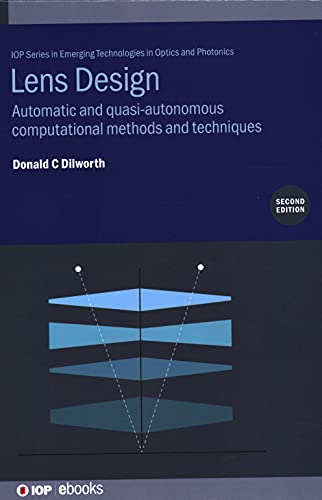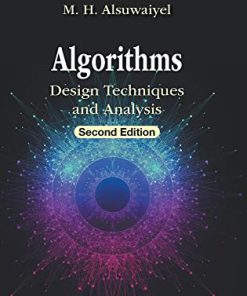Lens Design Automatic and Quasi Autonomous Computational Methods and Techniques 2nd Edition by Donald 9780750336956 0750336951
$50.00 Original price was: $50.00.$25.00Current price is: $25.00.
Lens Design Automatic and Quasi Autonomous Computational Methods and Techniques 2nd Edition Donald C. Dilworth – Ebook Instant Download/Delivery ISBN(s): 9780750336956, 0750336951

Product details:
- ISBN 10:0750336951
- ISBN 13:9780750336956
- Author: Donald
Lens Design (Second Edition)
Automatic and quasi-autonomous computational methods and techniques
Table contents:
Author biography
1 Preliminaries
1.1 Why is lens design hard?
1.1.1 The lens design landscape
1.1.2 Chaos in lens design
1.2 How to use this book
2 Fundamentals
2.1 Paraxial optics
2.2 Lagrange invariant, thin-lens equation
2.3 Pupils
3 Aberrations
3.1 Ray-fan curves
3.2 Abbe sine condition
3.3 Higher-order aberrations
3.4 Spot diagrams
3.5 Wavefronts and aberrations: the OPD
3.5.1 Image analysis
3.6 Chromatic aberration
3.6.1 Cemented doublets
3.6.2 Secondary color
4 Using a modern lens design code
4.1 Wide-angle pupil options
4.2 Ray aiming
4.3 Paraxial solves
4.4 The WorkSheet
4.4.1 The process of lens design
5 The singlet lens
5.1 Entering data for the singlet
6 Achromatizing the lens
7 PSD optimization
8 The amateur telescope
8.1 The Newtonian telescope
8.2 The Schmidt–Cassegrain telescope
8.3 The relay telescope
8.4 How good is good enough?
9 Improving a lens designed using a different lens design program
10 Third-order aberrations
10.1 Tolerance desensitization
11 The in and out of vignetting
12 The apochromat
13 Tolerancing the apochromatic objective
13.1 Fabrication adjustment
13.2 Transferring tolerances to element drawings
14 A near-IR lens example
14.1 Design approach
15 A laser beam shaper, all spherical
16 A laser beam shaper with aspherics
17 A laser beam expander with kinoform lenses
18 A more challenging optimization challenge
18.1 Glass absorption
19 Real-world development of a lens
20 A practical camera lens
20.1 Reusing dialog commands
21 An automatic real-world lens
22 What is a good pupil?
22.1 Which way is op? Orientation of pupil
23 Using DOEs in modern lens design
24 Designing aspheres for manufacturing
24.1 Adding unusual requirements to the merit function with CLINK
24.2 Defining an aberration with COMPOSITE
25 Designing an athermal lens
26 Using the SYNOPSYS glass model
27 Chaos in lens optimization
28 Tolerance example with clocking of element wedge errors and AI analysis of an image error
29 Tips and tricks of a power user
30 FLIR design, the narcissus effect
30.1 Narcissus correction
31 Understanding artificial intelligence
31.1 Error correction
31.2 MACro loops
32 The annotation editor
33 Understanding Gaussian beams
33.1 Gaussian beams in SYNOPSYS
33.2 Complications
33.3 Beam profile
33.4 Effect on image
34 The superachromat
35 Wide-band superachromat microscope objective
35.1 Vector diffraction, polarization
36 Ghost hunting
37 Importing a Zemax file into SYNOPSYS
38 Improving a Petzval lens
39 Athermalizing an infrared lens
40 Edges
40.1 A mirror example
41 A 90-degree eyepiece with field stop correction
42 A zoom lens from scratch
42.1 Zoom spacing
43 Designing a free-form mirror system
44 An aspheric camera lens from scratch
44.1 Encore
44.2 Coda
44.3 Tolerancing the aspheric lenses
45 Designing a very wide-angle lens
45.1 Wide-angle lens II
46 A complex interferometer
47 A four-element astronomical telescope
48 A sophisticated merit function
49 When automatic methods do not apply
50 Testplate matching
51 Automatic thin-film design
52 Automatic clocking of wedge errors
53 XSYS an expert-systems approach to lens design
54 DUV system with quarter-wave plate
55 Lens coatings, polarization
56 A custom coating with custom materials
57 Focusing x-rays
58 A singlet achromat
58.1 Single-element achromat with no DOE
59 Pupil aberrations and the optical image
59.1 Convolution MTF
59.2 Coherent imaging
Appendices
Appendix A
Appendix B
Appendix C
Appendix D
Appendix E
Appendix F
Read Less
People also search:
lens design automatic
lens designer
lens design tutorial
lens design examples
lens design software
You may also like…
Computers - Computer Science
Computational Peptide Science Methods and Protocols Thomas Simonson
Uncategorized
Mathematics - Mathematical Statistics
Mathematical Methods for Engineering and Science, 2nd 2nd Edition Merle C. Potter
Computers - Algorithms and Data Structures
Algorithms Design Techniques and Analysis 2nd Edition M. H. Alsuwaiyel
Mathematics - Mathematical Statistics











